
What is Product Strategy?
Strategy is both easy to understand and a complex and mysterious art. Like a game of chess, it is just a game, but to do it effectively, one must understand the contextual landscape, the capabilities of the actors on the board, and with a mastery of that nuance, navigate a path to success.
Effective product strategy is rooted in research, in order to achieve a deep understanding of our customers, competitors, and capabilities. By paying attention to the nuances in these areas, we can identify needs or desires of our customers that haven’t been met, weaknesses or blindness of our competitors, and disruptive opportunities to innovative how the problem space is addressed.
There are essentially three steps to defining a product strategy – the Product charter you’re starting with (implicit or explicit), the research that you’ll do to develop a nuanced understanding of your competitive landscape, and the strategy you’ll ultimately define based on and detailed understanding of the charter and competitive landscape. We’ll go through each of those here.
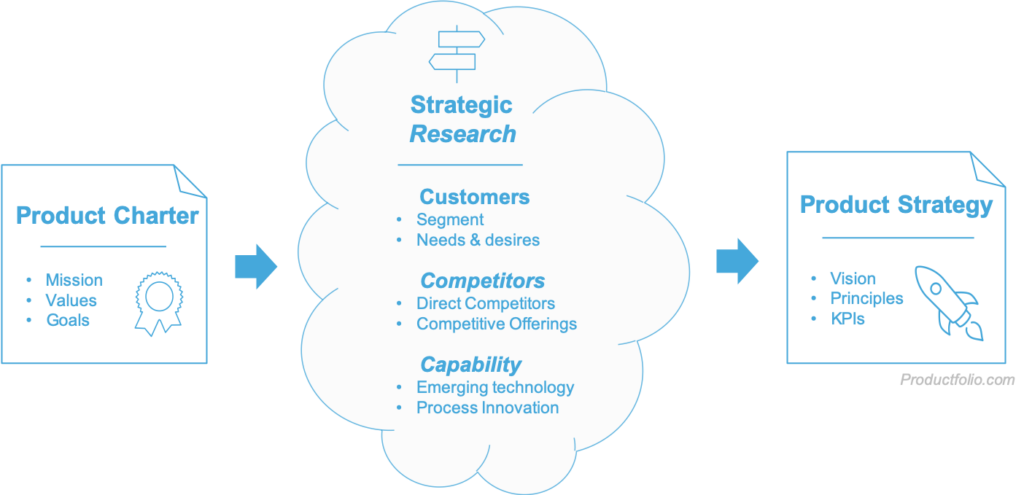
Business Alignment
The first thing to be clear on, is the role of Product Management within an organization and its relationship to the goal of Business. In large organizations, there are generally four levels of strategy and planning to be aware of – Corporate strategy, Business strategy, Functional strategy and Action Plans. In smaller companies this will likely be collapsed down to just 2-3 layers and the distinction of these different layers may not be as clear, but it’s good to think in these terms and keep this ‘normalized’ model in mind as a starting point.
At the top of the pyramid is a corporate strategy that determines what business to be in – this drives M&A activity, corporate initiatives and the budget allocations for the strategic business units of the corporation. Each Business Unit then (SBU) has a budget and a mission handed down from Corporate that they’ll determine Business strategy in response to. Missions and budget are then handed down to the functional groups such as Marketing, Engineering, and Product and they develop their own strategies to support the business strategy, and so forth. The action plans that follow are the tactical plans that support the cascade of aligned strategies that sit above.
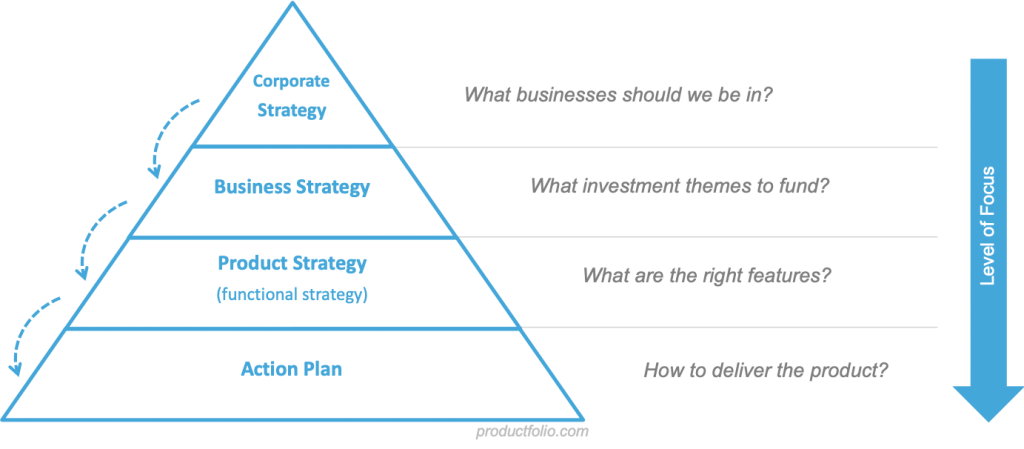
Product Management is a Functional that works with the domain of a product, to achieve a mission that is driven by the Business Unit. Thus, a critical aspect of Product strategy is ensuring your plan for the product, is closely aligned with the strategy and intention of your business sponsors. As Marty Cagan has said, “The business strategy and business portfolio planning provide a budget and a set of business metrics. The product organization then lives within that budget to pursue as aggressively as possible the best ways to hit those business metrics.” This is where a clearly articulated Product Charter can be helpful.
Product Charter
TThere is almost always an expectation from Business leaders about what Product Management will produce and that it is well-aligned with the goals and direction of the Business Strategy but it’s not always stated explicitly. When that happens, it is the responsibility of Product leadership to extract this information from business leaders, to ensure those expectations are declared and understood, thereby enabling Product to build a functional strategy on a solid foundation. The Product Charter can be very simple, starting the mission of the Product team, key business goals, and guiding values that will act as guard rails.
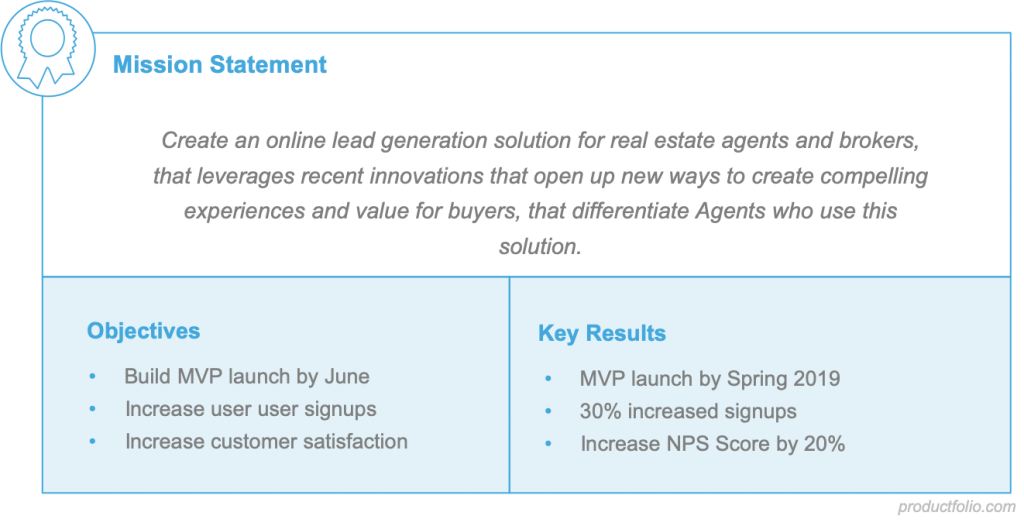
Strategic Research
With a Product Charter in place, it is time to dive into market research, to develop a deep understanding of the landscape within which we’re operating. This can be a bit of a deep dive in the beginning, but once you’re up and running, iterative improvement to this research is something you’ll want to keep up on, so you always have your pulse on the market, and are able to see opportunities when they arise.
Customer
We should always start our research with the customer. We’re on this journey at the behest of our Business sponsors in order to achieve our Business goals, but we accomplish it, by addressing the needs and desires of our customer. In fact, this is what makes Product Management a strategic function – it is our responsibility to understand the needs of the Customer and how to perform in the external market, in order to achieve Business goals.
To start this process, we really need to understand who the customers/prospects are. Every customer is a little bit different but generally speaking, there are groups that people naturally cluster into – so by understanding those key groups, and the needs and desires shared by that group, we can develop a much more nuanced sense of how to resonate with those users.
Customer Personas are a great tool for clarifying who those customer groups are. There are probably 3-5 different personas for every product that have overlapping needs which bring them to our product. We might say for example that a working mom, a sales professional, and a young person looking for a dating spot, all have overlapping needs of a nearby restaurant, but if you scratch below the surface, you’ll see the “why” for each of them is every different – the working mom needs quick and healthy food she can take home after work, the sales executive needs a quiet spot for a sales meeting, and the young person is looking for romantic ambiance.
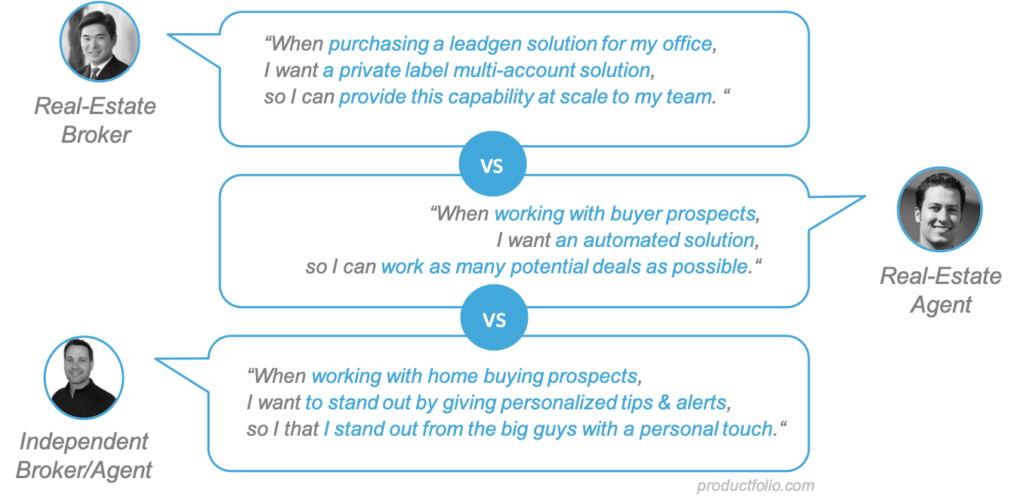
Understanding these nuances can help to understand more need or desire that can be served, creating more value for the customer and thus increased product-market fit. There are several tools and frameworks listed below, that can be useful for stepping through this analysis and developing a detailed understanding of your customers.
Useful Frameworks
Competition
It is not enough to understand what a customer wants and needs – we need to understand the unmet needs and desires. This means we need to develop a good sense for who our competitors are, the products they offer, the gaps in their offering, and what their future plans may be. With this understanding, we’ll be able to determine a differentiated value proposition that stands out in the market.
The first step is really knowing who our competitors are and what they’re capable of. Get to know everything about them such as where they’re based, what funding they’ve raised, how many employees, and how long they’ve been around. Also spend some time with their products and going a little gap analysis – this will give you a much better sense of who is leading, lagging, and innovating in the market. Once you have a sense for this, chart the data to make it easy to communicate and refer back to – The Gartner Magic Quadrant is a great framework for doing this.

Useful Frameworks
- Gartner Magic Quadrant
- Generic Competitive Strategies
- Competitive Gap Analysis
- Lumascape Landscape Diagrams
Capability
Finally, we need to look at recent technology and process innovations that we might be able to bring to bear. In a crowded market, having a better way of solving the problem can help to provide disruption and differentiation.
The Kano Model has become a popular way of describing the difference between Delighters and Must-Have features in a product. What’s sometimes missed in this model however, is the reverse line between the two, meaning that over time, a delighter becomes a must-have, once it is commonplace. Nicholas Carr made a similar point, when he said “What makes a resource truly strategic and a sustained competitive advantage – is not ubiquity but scarcity.”
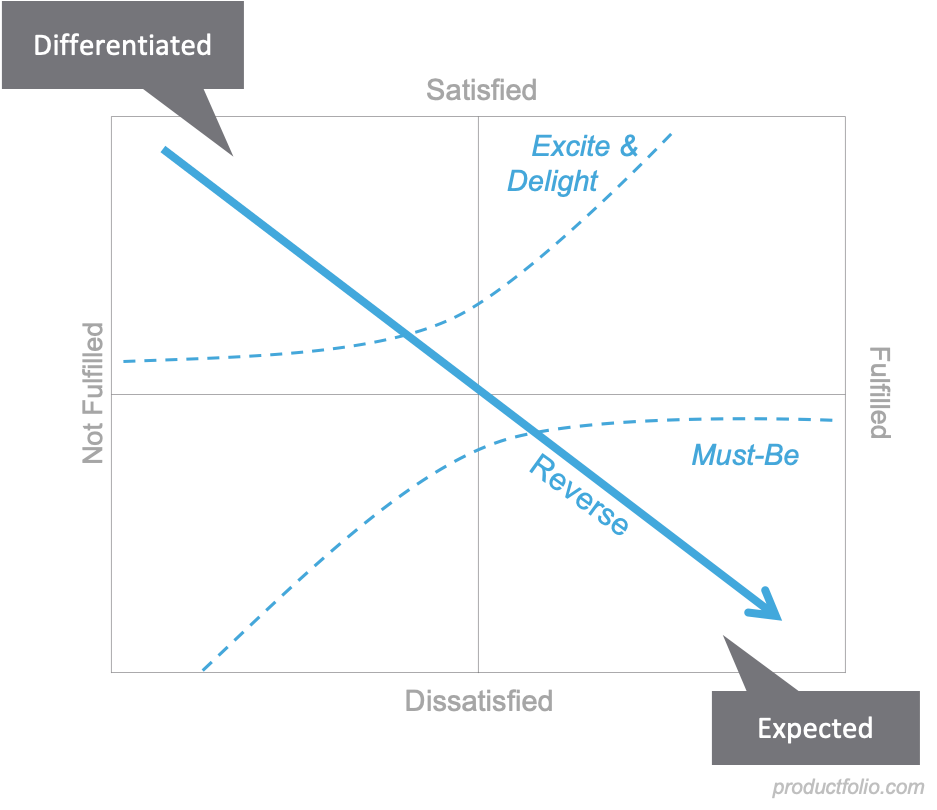
To that end, technology is always improving and even non-technical processes continue to evolve. Spend some time understanding the market to find out what is changing and what the opportunities might be in your industry, to apply these innovations to create additional value for customers – either through new experiences, increased efficiency, or consequently lower prices. .
Useful Frameworks
Finally, with these insights from our research about customers, competitors, and available capabilities – it’s time to begin formulating a product strategy. Product-Market fit is what sits at the nexus of these three things, and the culmination of all your research.
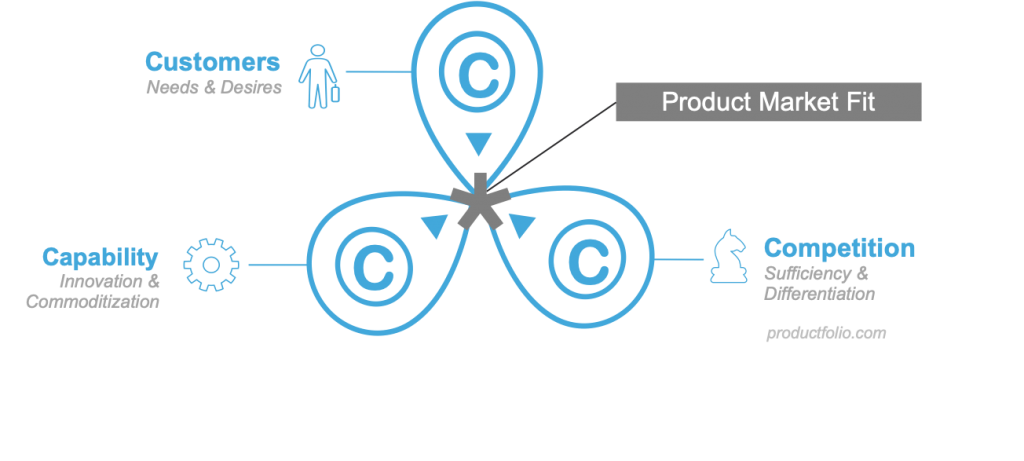
There are a number of frameworks that can be useful for constructing a differentiated position, once you’re clear on these details. For example, Generic Competitive Strategies suggests there are really only three positions that one can take – cost leadership if you’re early to market and able to grow quickly, differentiated product for when there’s something truly unique or disruptive hasn’t been realized yet, or by addressing a niche audience in a way that addresses their specific needs. You can also try using the Value Creation Plane to plot yourself and your competitors across a 2-dimensional value plane and systematically identify new ways to approach your solution that can differentiate and might resonate with your audience.
Spend some time exploring these frameworks and ideating possible options, then sharing these with your Business sponsors and customer research cohort, to get a sense which options might be a good fit.
Useful Frameworks
- Generic Competitive Strategies
- Value Creation vs Value Capture
- Value Creation Plane
- Product Vision Definition
Defining the Strategy
So far in this guide, we’ve covered the product charter, the 3 core aspects of strategic product research, and the frameworks for synthesizing together our insights into a cohesive product strategy. In this last step, it’s time to create the Product Vision statement and articulate the pillars of our product strategy that are supported by vision.
Product Vision Statement
The Product Vision is a ‘call to arms’ for the team – it concisely articulates the future-state of this product, 3-5 years out. The goal is to keep this as short as possible (1-3 sentences) and every word should count, so take the time to think this through and reflect all of the hard work you’ve done in the research leading up to this.
A good format for a Product Vision is “A [what] that will [why] for [who] by [how]”. The ‘What’ variable is your chance to describe the tangible thing that you’ll be creating. ‘Why’ expresses the unmet customer need or desire. ‘Who’ indicates who we’re serving and ‘How’ describes the key aspects of the ‘what’ that provide the differentiated value.
The ‘One Pager’
Finally, the Product Strategy “one pager” brings together the product vision, your customer personas, and competitor profiles, into one page. So far, we’ve only talked about the directional strategy but in the next step, we’ll discuss product planning where we’ll also define the underpinnings for that planning such as defining Objectives & KPIs, and planning themes. Collectively these details can be expressed on a single page and provide a concise representation of strategic direction for your product – this is everything that’s needed to inform the team’s product discovery and roadmapping efforts.
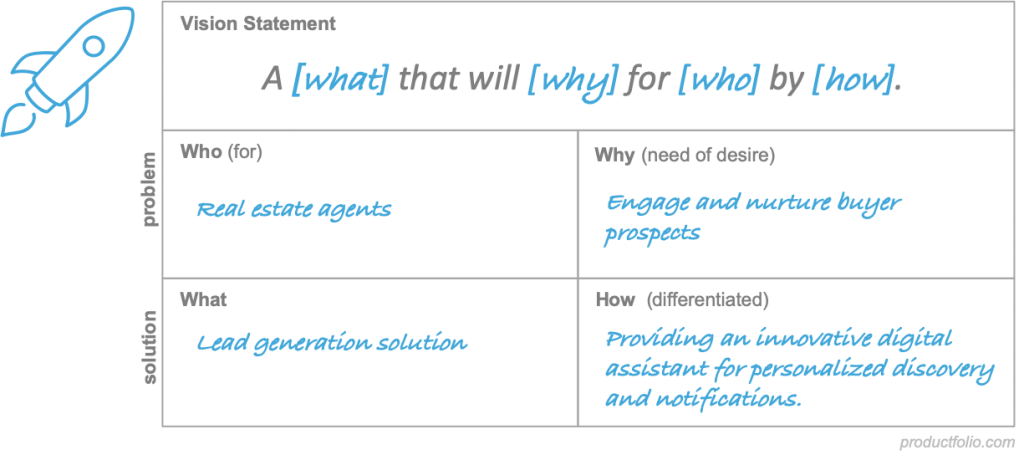
Conclusion
There we have it – we’ve developed a Product strategy, starting with an understanding of our charter from our business, and did strategic research to understand the needs of our customers, our competition and availability capabilities. The next step is to begin Ideating actions we can take to realize this strategy and development of our actionable Product Plan.
Other Learning Guides
Product Planning (roadmap)
Prioritization, alignment and sequencing of opportunities on a roadmap provides a plan for achieving business goals and the product vision.
Role of Product Management
Product Management is different in every organization, but there are fundamentals that transcend the differences and define the role.
Ideation & Idea Management
Ideas for features and improvements can come from anywhere. The key is knowing how to organize and qualify those ideas.


